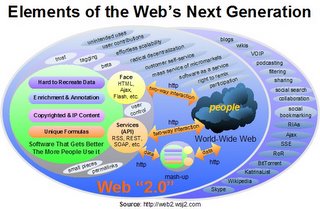From a technical standpoint there is clearly a new set of "Web 2.0 design patterns" and technologies (Web Services, RSS, AJAX, OpenSource). New user paradigms such as Collective Intellegence, Social Media and all things living ditigally online. The business models can monetize the long tail market through ad revenue or upsell services from their free base offering. Google has shown that using algorithms to automate all aspects of the business model is essential to scale and survival in the long term. Something is clearly happening here.....
Shedding More Light with the following 3 concept illustrations:
1. Web 2.0 Examples (Source: O’Reilly)
| Web 1.0 | | Web 2.0 |
| DoubleClick | --> | Google AdSense |
| Ofoto | --> | Flickr |
| Akamai | --> | BitTorrent |
| mp3.com | --> | Napster |
| Britannica Online | --> | Wikipedia |
| personal websites | --> | Blogging |
| evite | --> | upcoming.org and EVDB |
| domain name speculation | --> | search engine optimization |
| page views | --> | cost per click |
| screen scraping | --> | web services |
| publishing | --> | Participation |
| content management systems | --> | Wikis |
| directories (taxonomy) | --> | tagging ("folksonomy") |
| stickiness | --> | Syndication |
2. Web 2.0 Visualization (Source: O’Reilly)
You can visualize Web 2.0 as a set of principles, practices and technologies.
3. Web 2.0 Check List
- Give us your email address, we'll let you know when it's ready!
- Public beta alpha
- Tags
- Feeds for everything
- Built with Rails
- Sprinkled with Ajax
- Yellow fade
- Blue gradients
- Big icons
- Big fonts
- Big input boxes
- REST API
- Google Maps mashup
- Share with a friend
- TypePad blog for a peek inside the team
- Feature screencasts
- Hackathons for new features
- Development wiki
- Business model optimized for the long tail
- It's Free!/AdSense revenue stream






No comments:
Post a Comment